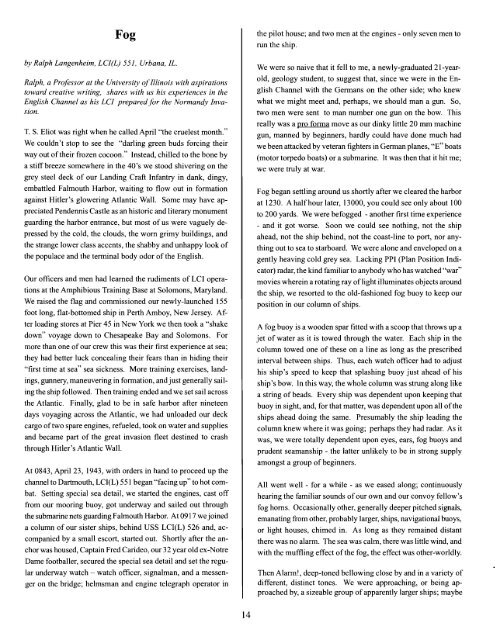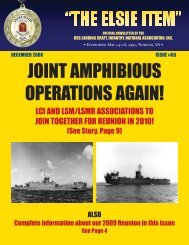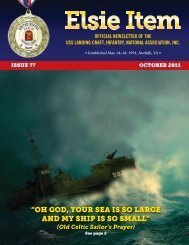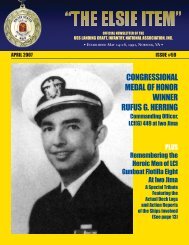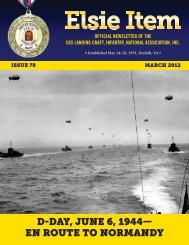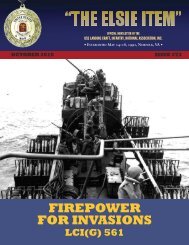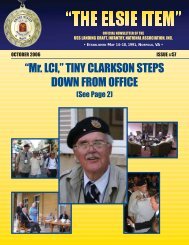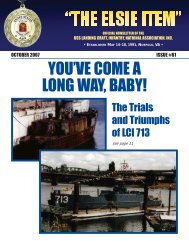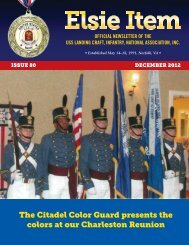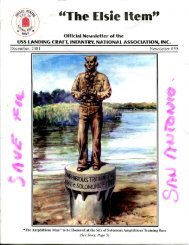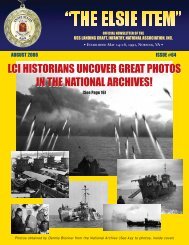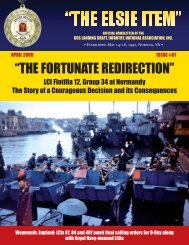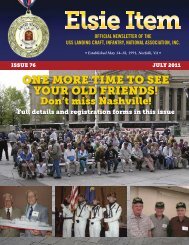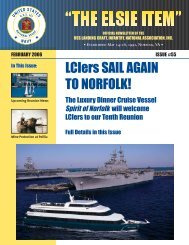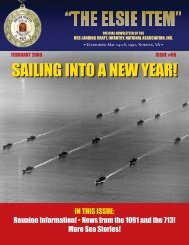"The Elsie Item" - USS Landing Craft Infantry National Association
"The Elsie Item" - USS Landing Craft Infantry National Association
"The Elsie Item" - USS Landing Craft Infantry National Association
Create successful ePaper yourself
Turn your PDF publications into a flip-book with our unique Google optimized e-Paper software.
Fogby Ralph Langenheim, LCI(L) 551, Urbana, IL.Ralph, a Professor at the University ofIllinois with aspirationstoward creative writing, shares with us his experiences in theEnglish Channel as his LCI prepared for the Normandy Invasion.T. S. Eliot was right when he called April "the cruelest month."We couldn't stop to see the "darling green buds forcing theirway out oftheir frozen cocoon." Instead, chilled to the bone bya stiff breeze somewhere in the 40's we stood shivering on thegrey steel deck of our <strong>Landing</strong> <strong>Craft</strong> <strong>Infantry</strong> in dank, dingy,embattled Falmouth Harbor, waiting to flow out in formationagainst Hitler's glowering Atlantic Wall. Some may have appreciatedPendennis Castle as an historic and literary monumentguarding the harbor entrance, but most of us were vaguely depressedby the cold, the clouds, the worn grimy buildings, andthe strange lower class accents, the shabby and unhappy look ofthe populace and the terminal body odor of the English.Our officers and men had learned the rudiments of LCI operationsat the Amphibious Training Base at Solomons, Maryland.We raised the flag and commissioned our newly-launched 155foot long, flat-bottomed ship in Perth Amboy, New Jersey. Afterloading stores at Pier 45 in New York we then took a "shakedown" voyage down to Chesapeake Bay and Solomons. Formore than one of our crew this was their first experience at sea;they had better luck concealing their fears than in hiding their"first time at sea" sea sickness. More training exercises, landings,gunnery, maneuvering in formation, and just generally sailingthe ship followed. <strong>The</strong>n training ended and we set sail acrossthe Atlantic. Finally, glad to be in safe harbor after nineteendays voyaging across the Atlantic, we had unloaded our deckcargo oftwo spare engines, refueled, took on water and suppliesand became part of the great invasion fleet destined to crashthrough Hitler's Atlantic Wall.At 0843, April 23, 1943, with orders in hand to proceed up thechannel to Dartmouth, LCI(L) 551 began "facing up" to hot combat.Setting special sea detail, we started the engines, cast offfrom our mooring buoy, got underway and sailed out throughthe submarine nets guarding Falmouth Harbor. At 0917 wejoineda column of our sister ships, behind <strong>USS</strong> LCI(L) 526 and, accompaniedby a small escort, started out. Shortly after the anchorwas housed, Captain Fred Carideo, our 32 year old ex-NotreDame footballer, secured the special sea detail and set the regularunderway watch - watch officer, signalman, and a messengeron the bridge; helmsman and engine telegraph operator inthe pilot house; and two men at the engines - only seven men torun the ship.We were so naive that it fell to me, a newly-graduated 21-yearold,geology student, to suggest that, since we were in the EnglishChannel with the Germans on the other side; who knewwhat we might meet and, perhaps, we should man a gun. So,two men were sent to man number one gun on the bow. Thisreally was a pro forma move as our dinky little 20 mm machinegun, manned by beginners, hardly could have done much hadwe been attacked by veteran fighters in German planes, "E" boats(motor torpedo boats) or a submarine. It was then that it hit me;we were truly at war.Fog began settling around us shortly after we cleared the harborat 1230. A halfhour later, 13000, you could see only about 100to 200 yards. We were befogged - another first time experience- and it got worse. Soon we could see nothing, not the shipahead, not the ship behind, not the coast-line to port, nor anythingout to sea to starboard. We were alone and enveloped on agently heaving cold grey sea. Lacking PPI (Plan Position Indicator)radar, the kind familiar to anybody who has watched "war"movies wherein a rotating ray oflight illuminates objects aroundthe ship, we resorted to the old-fashioned fog buoy to keep ourposition in our column of ships.A fog buoy is a wooden spar fitted with a scoop that throws up ajet of water as it is towed through the water. Each ship in thecolumn towed one of these on a line as long as the prescribedinterval between ships. Thus, each watch officer had to adjusthis ship's speed to keep that splashing buoy just ahead of hisship's bow. In this way, the whole column was strung along likea string of beads. Every ship was dependent upon keeping thatbuoy in sight, and, for that matter, was dependent upon all oftheships ahead doing the same. Presumably the ship leading thecolumn knew where it was going; perhaps they had radar. As itwas, we were totally dependent upon eyes, ears, fog buoys andprudent seamanship - the latter unlikely to be in strong supplyamongst a group of beginners.All went well - for a while - as we eased along; continuouslyhearing the familiar sounds ofour own and our convoy fellow'sfog horns. Occasionally other, generally deeper pitched signals,emanating from other, probably larger, ships, navigational buoys,or light houses, chimed in. As long as they remained distantthere was no alarm. <strong>The</strong> sea was calm, there was little wind, andwith the muffling effect ofthe fog, the effect was other-worldly.<strong>The</strong>n Alarm!, deep-toned bellowing close by and in a variety ofdifferent, distinct tones. We were approaching, or being approachedby, a sizeable group of apparently larger ships; maybe14


